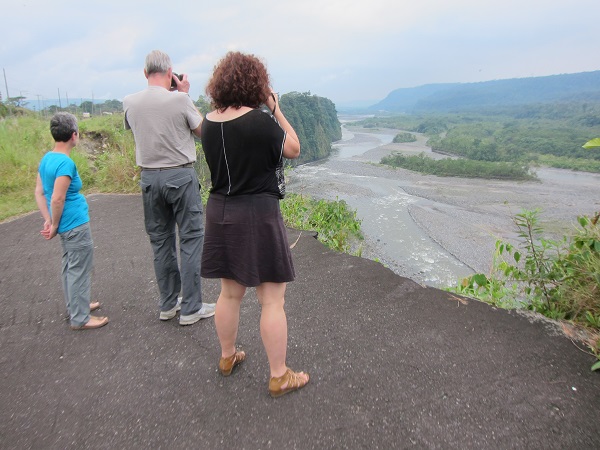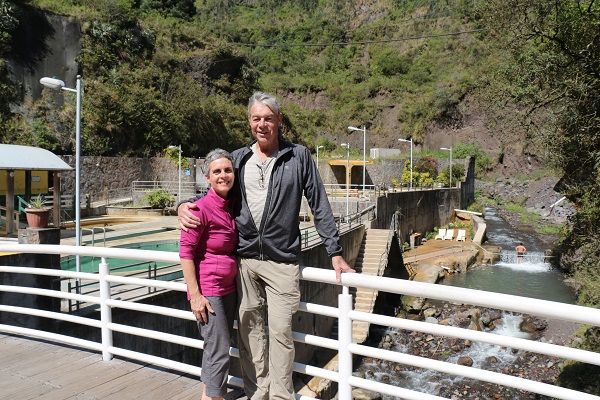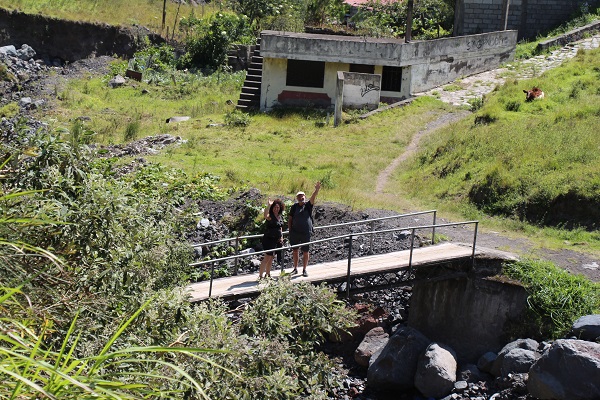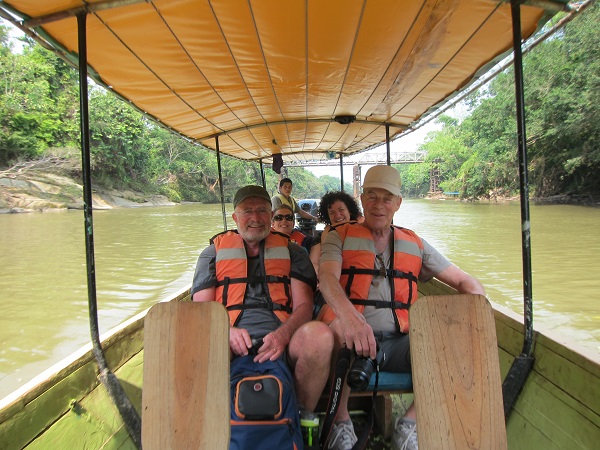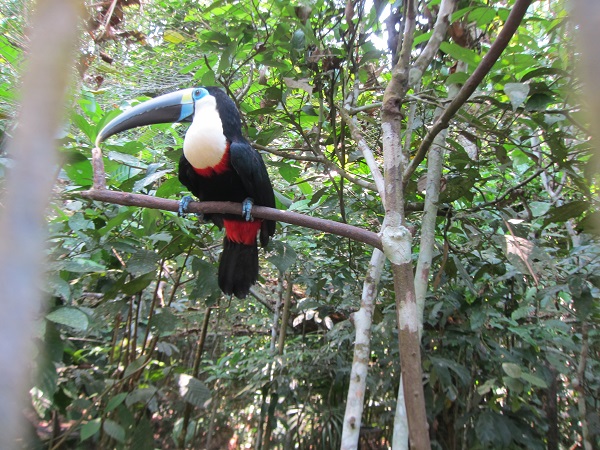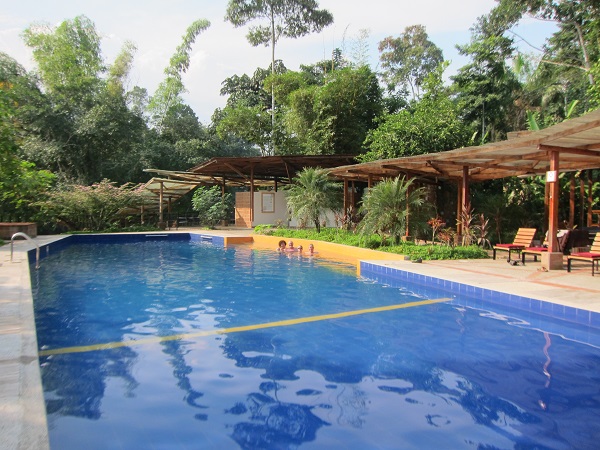 We have just returned to Mindo from an amazing 7 day excursion. It is impossible to capture on film what we saw with our eyes and even more difficult to describe in words. …but let me try. First, Ecuador is filled with active volcanoes and mountain peaks rising into the sky. Unlike the Rockies, you often drive over the mountains rather than through them. This takes you to altitudes of more than 4000 metres on roads that climb steadily and then drop just as dramatically down the other side.
We have just returned to Mindo from an amazing 7 day excursion. It is impossible to capture on film what we saw with our eyes and even more difficult to describe in words. …but let me try. First, Ecuador is filled with active volcanoes and mountain peaks rising into the sky. Unlike the Rockies, you often drive over the mountains rather than through them. This takes you to altitudes of more than 4000 metres on roads that climb steadily and then drop just as dramatically down the other side.
I took this picture (below) of Mount Cotopaxi, about 50 km south of Quito. It is the second highest summit in Ecuador, reaching a height of 5,897 m. It is one of the world’s highest volcanoes. Cotopaxi’s most recent eruption lasted from August 2015 until January 2016. Since records have been kept, Cotopaxi has erupted more than 50 times.
The landscape is breathtaking. Valleys flow with rivers, waterfalls are everywhere, and the mountains seem to go on forever. Our trip took us longer to get to Baños because we kept stopping to take pictures of this wondrous scenery.
Our first destination was Baños de Agua Santa where we booked two nights in Pasada J hostel. It turned out to be a great location directly across from the Piscinas de la Virgen (a waterfall). At the base of the waterfall are the thermal baths of the same name. Baños means bath in Spanish and so it is the same word used to identify toilets. Similar to us calling our toilets ‘bathrooms’.
Baños is located on the northern foothills of the Tungurhua volcano. Tungurahua’s volcanic activity has been characterized by frequent powerful ash explosions and lava flows. Volcanic activity can often be seen from Baños but we weren’t lucky enough to see it on our visit. It is the volcano that provides the heated waters for the thermal baths.
We went to Baños for a few reasons. We wanted to experience the healing powers of the thermal baths, it is well known for its many activities, we heard you can get a great inexpensive massage, and it is the gateway to the Amazon. Shortly after we arrived, we took a taxi up to the Piscinas El Salado baths. There are varying degrees of heat in the pools and the many minerals make them look dark brown. They were a bit institutional looking but so very relaxing.
Our hostel had its own spa and Marilyn opted for a facial and massage combination. I set out to explore the city streets and was a bit surprised to find so many places offering massage treatment, saunas, medicinal mud baths and a range of other treatments. I opted for a massage and was pleasantly surprised by the quality for a low cost of only $25.00.
ñ
I got up the next day at 5:30am and walked to the other thermal pools close to our hostel. At that time of the morning, there were only local residents in the pools – no tourists. It was a great way to start the day. After a hearty breakfast we were all packed and ready for the next leg of our journey. It was a four hour drive from Baños to Tena where we stopped for some lunch. After eating, we drove another 40 minutes to the Arajuno River Bridge where we met our guides from Itamandi Lodge. We were now in ‘The Orient’, the region of Ecuador that encompasses the Amazon basin.
There are many rivers and tributaries flowing from this part of Ecuador through the Amazon to the Atlantic Ocean. Itamandi lodge is located on Rio Arajuno which joins the much larger Rio Napo. It is possible to go much deeper into the Amazon but our location was truly amazing.
Itamandi is an ecolodge using solar power and taking many steps to protect the Amazon environment. It does not have air conditioning or fans despite the hot humid temperature. It is also a ‘Community’ affiliated lodge which means it works in harmony with the local indigenous peoples. The local people are of the Kichwa community. “Ita” is a Kichwa word meaning community and “Mandi” is a local plant found in the area – thus the name for the lodge, Itamandi.
We chose the 3 night/4 day Wildlife Experience package offered by the lodge. We originally tried to book on the weekend but the lodge was full. We opted for Monday to Thursday and can you believe it….we had the lodge all to ourselves for the first three days. You can’t imagine the personal attention we received.
After a 20 minute motorized canoe ride down the Rio Arajuno we arrived at Itamandi around 3pm. The first night we went for a night walk to hear the nocturnal sounds and to look for a variety of creatures. We saw a variety of insects (mainly spiders) and a huge tarantula.
The next morning we got up at 5am and headed 20 minutes upstream to visit a parrot clay lick (Saladero). This is a place where hundreds of parrots and parakeets gather in order to obtain the minerals that will help them digest the fruits or seeds they have consumed. Hearing them arrive in the treetops was an unbelievable chatter and we were able to get up fairly close to the clay lick to see them consume the soil which is rich in minerals.
To be honest, we were on a fairly busy schedule. After coming back to the lodge, we had breakfast and soon headed out again on the river. This time we went out to the much larger Rio Napo to visit ‘Amazoonia Rescue Centre’ which houses a lot of Amazon wildlife. Unfortunately, all of the animals, birds, and reptiles, were being housed in the centre because they could no longer survive on their own in the wild. Many got into this condition because of humans who either injured them or kept them as pets.
Just prior to visiting the rescue centre, our guides took us further up river to look for monkeys. We were not disappointed. First we saw spider monkeys and then farther up the river, we encountered a large number of Wooly monkeys. They were coaxed from the interior to the river bank with watermelon and we had a front row seat to their antics.
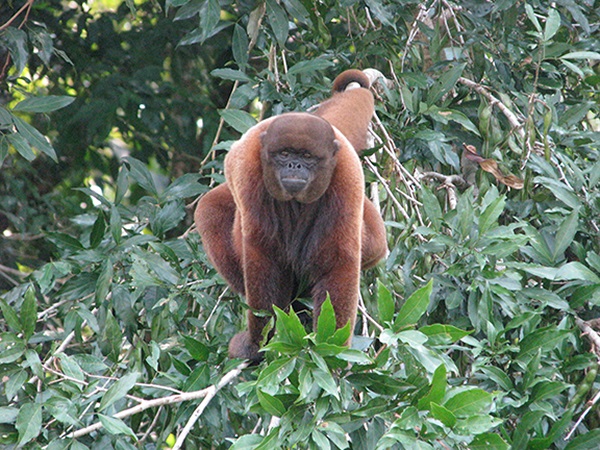 Throughout our river trips and hiking adventures, we’ve seen an amazing number of beautiful birds. Now we went off in search of one particular bird called the Crested Hoatzin. This involved a hike where we also got to experience using a blow gun used by the Kichwa people for hunting.
Throughout our river trips and hiking adventures, we’ve seen an amazing number of beautiful birds. Now we went off in search of one particular bird called the Crested Hoatzin. This involved a hike where we also got to experience using a blow gun used by the Kichwa people for hunting.
Isaias showed us how to hit the small wooden target and Jim followed with a direct hit. Feeling the pressure, I took the gun up to my mouth and fired…..bingo….right on the target next to Jim’s dart. Marilyn managed to hit the target on her second try and Patricia….well it is a pretty heavy weapon.
We came back out to the river at a different location but Alfredo was waiting for us with the boat and a nice lunch packed by the kitchen staff from Itamandi. We also got to go for a swim in the Rio Napa.
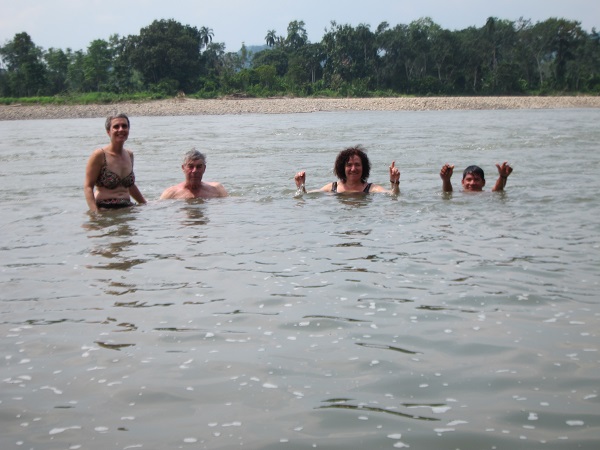 We still weren’t finished with our first full day in the jungle. We took the boat further upstream to a small town called Ahuano where we got to see a demonstration on how indigenous people make pots and other clay items by hand.
We still weren’t finished with our first full day in the jungle. We took the boat further upstream to a small town called Ahuano where we got to see a demonstration on how indigenous people make pots and other clay items by hand.
In Ahuano, we walked up the street to a small shack serving beer and treated ourselves to a cerveza. By the time we got back to Itamandi, it was almost time for dinner but we had time for a swim in the lodge pool (which we had all to ourselves). After dinner we played our daily games of euchre and crashed early. Jim and Patricia took a little longer to get to sleep because they found a bat in their room and had the staff remove it. Wow, what a great day.
This blog posting is turning out to be a lot longer than my previous ones but so much has happened and I’m not sure how else to capture what we experienced. Day 3 is actually the day I was most looking forward to. It was our ‘cultural day’ and a chance to visit a Kichwa village. This is actually the home village of our guides so we met several members of their family. There are approximately 130 people living in the village and they have a small school where the children also learn their native Kichwa language.
The women of the village had prepared a lot of food for us to sample. Most was of different types of plants and various types of fish. There was also a large cooked caterpillar/worm-like bug and I’m pleased to say I ate one. It reminded me of the mopani worms we served in our restaurant in Africa.
As I’ve mentioned before, Ecuadorians are so friendly and love to engage with travelers and tourists. We felt so welcome in the village. Some school children performed a traditional dance and got us up to join them. As part of Carnival, faces are painted with a plant based dye and Marilyn and Patricia joined right in.
We all felt enriched by the visit to the traditional community and returned to the lodge knowing this was a unique experience. After lunch, we did our final hike when Isaias showed us many medicinal plants. He also showed us how to make sombreros from plant leaves, a crown for the chief, how a cleansing ceremony is performed, and which plants can be eaten.
 People we met in the jungle say tourism has brought new opportunities for indigenous people. I asked Isaias what he does with the money he earns from his job and he told me he will buy land for his children so they can farm, he buys school supplies for his children and others, and he can make sure the people of his village always have enough food. This too reminded us of Africa where people get their status from how much they help others rather than how much they own for themselves. It is a beautiful concept and one I hope they can continue as their world changes around them.
People we met in the jungle say tourism has brought new opportunities for indigenous people. I asked Isaias what he does with the money he earns from his job and he told me he will buy land for his children so they can farm, he buys school supplies for his children and others, and he can make sure the people of his village always have enough food. This too reminded us of Africa where people get their status from how much they help others rather than how much they own for themselves. It is a beautiful concept and one I hope they can continue as their world changes around them.
Despite the amazing memories we made in “The Orient”, we were happy to arrive back in Mindo. We came home a different route which completed a loop from Quito to Baños to Tena to Baeza and back to Quito. We drove up over the highest road in Ecuador and arrived back in Mindo by late afternoon on Thursday. Today (Saturday) we are invited to a party. This weekend also marks the beginning of Carnival which will run until Tuesday Feb 28. Throughout the next few days, we may expect to get water bombed, sprayed, doused with cooking oil and flour, and painted. I’ll let you know how it goes.



